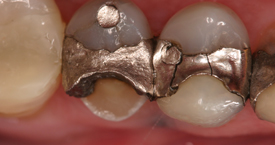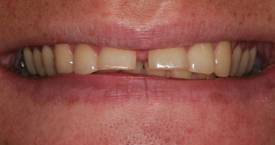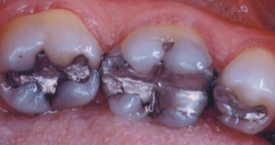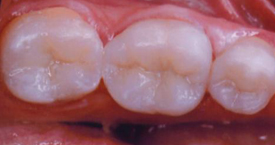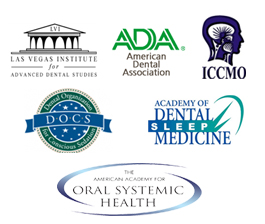- What causes a tooth to break?
When a tooth is drilled and a silver amalgam filling is placed into a tooth, the structural integrity of the tooth is compromised. Just like when water freezes in a pipe, when the silver mercury filling begins to expand, the increasing structural stresses must be relieved. Cracks appear and happen in tooth structure to relieve the increasing stress. As these cracks propagate through tooth structure, pieces of the tooth can break away. When this happens, it carries a certain risk of injuring the nerve or breaking below the gum line. Sometimes in order to save the tooth it is necessary to do a root canal procedure and/or to surgically move the bone and gum lower to expose the fracture line. Functional forces such as biting, grinding and chewing, in addition to hot and cold thermal expansion and contraction, can stress a tooth which is cracked to the point it eventually will break. (It is of interest to note that thermometers are traditionally made using mercury because of its predictable response in expansion and contractoin due to changes in temperature. roughly 50% by volume of a silver filling is made up of mercury.)
- What can be done to fix a chipped or broken tooth?
Traditionally, when a tooth breaks or cracks, it has been necessary to place a crown on the affected tooth. This is because of the need for a strong restoration to hold the parts of the tooth together. With today’s advancements in dental materials and technology, we now have the ability to bond tooth-colored resins and pressable ceramics that will restore the broken tooth and make it strong again.
- Why do teeth with fillings break?
Forces placed on the walls of the cavity by the expanding silver filling material, in concert with biting and functional forces, eventually weaken the tooth to the point it breaks. The damage to the tooth is sometimes sufficient to require root canal therapy, gum surgery and/or orthodontics to make the tooth repairable again.
- Can adults benefit from braces!
- What are porcelain veneers?
New types of porcelain are now allowing us to place thin shells of very strong porcelain on discolored, mal-aligned and misshapen front teeth to create a "Hollywood" smile. What was once relegated to dentists in Beverly Hills, can now be safety done here in the Tri-Cities in a far more conservative and less expensive manner.
- How can I fix gaps and spaces between my teeth?
- How can I make dentistry affordable?
Dentistry is and has always been a discretionary health dollar. Many expenses in our budgets often seem to take priority. For example, Christmas, summer vacations, boat and 2nd car payments, dining out, etc., all conspire to beat out dentistry as a budgeted priority. In this regard it is fundamentally a priorities game. Dental insurance is a help for some people, but even there, this pre-paid dental support lacks the power to help accomplish significant amounts of dentistry. As a consequence it is important to prioritize and budget the family and personal budget so as to afford necessary dental work. Additionally, we now have the ability to use alternative methods of financing which allows people to receive necessary treatment and to spread out the payments in a comfortable manner. We do the same no less for our cars, boats, vacations, and often Christmas. Why not our health?
- Is Mercury safe in my fillings?
There is considerable debate currently regarding whether mercury is a safe component for dental fillings. "Officially" the jury is still out on this one. We know that in many people there is considerable concern over its safety. Competent medical supervision by physicians trained in this area, should be sought if you have concern with this issue. When it is considered that these fillings tend to expand over time and thereby cause cracking and fracturing of the tooth structure, to say nothing of their un-esthetic looks, and when given the choice, most people prefer a more esthetic and equally durable tooth-colored restoration.
Scientifically, it is well accepted that mercury is a heavy metal which as a neurotoxin is considered dangerous enough to require special handling and consideration prior to it being implanted into the body (fillings), as well as after it is removed from the tooth. It seems logical, despite its proclaimed safety, that where possible, it should be avoided and alternative high quality restorative materials used. Historically, it has been used primarily because it provides a cheap way to solve urgent dental problems due to dental decay, for hundreds of millions of people. Without question there are superior restorative materials available. Fortunately, we enjoy space-age restorative resins and ceramics which are very suitable for most restorative considerations. Additionally, where necessary, traditional dental gold can also prove to be a superior choice. While costs for these modern materials may still be relatively higher than for silver mercury, in our opinion, the higher quality makes these newer materials preferable.
- What exactly are tooth colored fillings?
New composite resins and ceramic porcelains have recently expanded the restorative options available for fixing teeth problems. This has given rise to the ever popular demand for cosmetic dentistry – that is, restoring teeth to look like teeth. These new materials fortunately allow us to be more conservative to tooth structure than other traditional methods.
- How can I fix my bad breath?
Mouth odor is caused generally by Volatile Sulfur Compounds (VSC’s) which are made by bacteria and other decaying organic debris in the mouth. Typically, these bacteria hide on the surface of the tongue, between the teeth, and under the gums. Using a commercial mouthwash usually only covers up the odor without correcting the underlying problem. Correction ALWAYS involves anti-microbial measures to eliminate and control the bacterial populations in the mouth. This includes meticulous oral hygiene with floss and toothbrush, and should also include an effective anti-microbial mouth rinse such as solutions containing chlorine dioxide (Retardent), or other special prescription and/or dentist dispensed rinses. Efforts to fix bad mouth odor that do not include a dentist and/or dental hygienist, usually come to naught. Therefore it is important to work closely with dental health professionals while you are working to get in charge of this problem. People taking certain medications which may dry the mouth or cause a metallic taste, or people with chronic sore throats and tonsils or draining sinus areas, should also consider medical attention to further eliminate causes for bad breath.
Dental FAQs...
- What causes a tooth to break?
- What can be done to fix a chipped or broken tooth?
- Why do teeth with fillings break?
- Can adults benefit from braces!
- What are porcelain veneers?
- How can I fix gaps and spaces between my teeth?
- How can I make dentistry affordable?
- Is Mercury safe in my fillings?
- What exactly are tooth colored fillings?
- How can I fix my bad breath?

